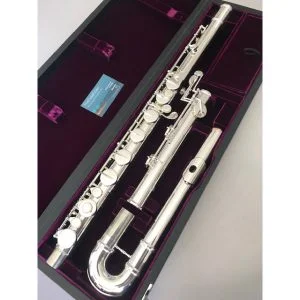Tone, Texture & Technique: Mastering the Alto and Bass Flute Duo

The alto and bass flute duo is not only a low-end expansion into the flute family, it is a very transformative force in modern flute playing. These larger, darker-voiced instruments impart a world of tonal warmth, textured colors, and delicate shades that are not afforded to a solo, standard C flute.
Alto and bass flutes resonate with deep emotional intensity, cinematic vibrancy, and a bold tonal presence that transforms solo pieces, chamber groups, and innovative ensembles. Learning to play these flutes in collaboration requires mastering everything from the breath to the embouchure to style-specific techniques. It refashions the way a flutist hears, tells stories, and exegetes.
In this blog, we will discuss how mastering tone, texture, and technique enhances your skills with the alto and bass flute duo.
The Deep Voice of the Flute Family: Why Alto and Bass Flutes Matter?
The alto and bass flutes distinguish themselves from the other flutes by both range and a peculiar presence in solo or ensemble music.
- Expanding The Sound Possibilities: The two flutes descend into lower registers and lend an arrangement with beauty, power, potency, and velvet tones. They lend resonance and populate the upper half of the spectrum in ways the usual C flute can never dream of.
- Versatile and Crossing Genre Boundaries: They are slowly emerging in jazz, electroacoustic composition, film scoring, and ambient music. Their adaptability has given composers and performers fresh avenues to explore in their stories.
- Visual Impact: Along with their size and curved headjoint, versatility and larger sound put the bass flute in the realm of spectacles. The audience is often mesmerized by the elegant instruments’ very eccentric look and feel.
- Underrated Emotional Range: Low register gives tones which can be melancholic, earthy, and hauntingly beautiful, but go well together with brighter woodwinds. They are quite apt for pieces that need introspective or moody phrasing.
Tonal Architecture: Crafting Warmth, Depth, and Resonance
Developing tone on the alto and bass flutes is an art of finesse, breath control, and mindful practice.
- Breath: On any flute, the air must be allowed to flow freely like a gentle stream. A relaxed yet firm breath pressure ensures the tone remains steady, especially in the lower register, where tone tends to become feeble.
- Shape Your Sound: Players must consider the variable embouchure, adjusting in minute degrees to gain the right angle and depth of tone, particularly in the low register. Each subtle modification will materially affect how the color and projection of the sound come out.
- Give It Its Weight: Being heavier by nature, the tonality of the bass flute provides the much-needed foundation to hold an ensemble together or to float away magnificently with the clarity of a solo. It stands out at the composer’s call, or it prefers to melt and become a mere shadow in contrast.
- Warmth Is Life: Particularly in wooden heads or handcrafted models, the warmth and resonance are extensions of the flutist’s name. For many professionals, their warmth of tone is almost their life as an artist.
Textural Storytelling: Using the Flute Duo to Create Musical Layers
Together, alto and bass flutes create unique textures. They weave conversing sonorities with richness.
- Layered Harmonics: Altos and basses can switch roles from time to time for harmonic dialogues of deep contrast in the duo or ensemble settings. These interactions can resemble natural overtones, thereby widening harmonic possibilities.
- Ambient Textures: Considered emotional interpreters in films and plays, the set rarely gets through many notes. One soft note can greet tension, nostalgia, or mystery.
- Electronic Collaborations: With effects such as reverb or delay, bass and alto flute can build luxuriant soundscapes for ambient and experimental music. This combination has quickly become the favorite of loop and electroacoustic artists.
- Contrasting Characters: Use the alto for warm mid-range melodies and the bass for bold, resonant foundations. It is a textural conversation that even a student flute player can appreciate. They can then be lead or harmony, providing endless layers for creativity.
Technique Reimagined: Adjusting Fundamentals for Larger Flutes
Playing the great low flutes involves a different set of skills and conditioning of approach-thinking on the lines of other possibilities that an experienced player might entertain.
- Finger Reach And Body Posture: A longer tube and wider key spacing call for some degree of hand flexibility and a conscious adjustment of posture to prevent soreness. You may need some ergonomic refitting or training in posture to maintain comfort in the long run.
- Embouchure Adaptation: The alto and bass flutes differ from the typical concert flute in that they demand a looser and more front-airstream alignment in order to avoid being breathy. Your embouchure’s shape and control potentials must evolve to embrace the instrument’s dimensions.
- Dynamic Control: Playing soft passages with clarity and projecting loud sections without cracking takes nuanced knowledge of airspeed and aperture. Mastery of the balance would place one in the realm of outstanding performance, whereas lack of it would barely categorize as adequate.
- Slow And Focused Practice: Tone and technique-building drills often involve returning to basics with conscious warm-ups, long tones, and register exercises. Whether you are considering upgrades or comparing options like the Yamaha piccolo flute price, perseverance and precision will bring about massive improvements in tonal control and musical confidence.
Wrapping It Up
Mastering the alto and bass flute duo defies the idea of simply playing lower tones. It allows another realm of expression, color, and technical shades to be realized. These instruments need a lot of patience, trial and error, and thinking outside the box. Whether layering sound for the cinematic world, redefining solo performance, or delving into new repertoire, the alto and bass flutes become a strong voice for the contemporary flutist. Pairing the two transforms the pitch range and expands a modern musician’s artistic vision and approach.





